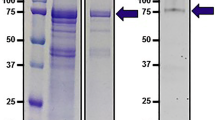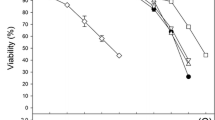Abstract
Dextran sulfate 5,000 Da (DS), a sulfated polysaccharide, has been used in recombinant mammalian cell cultures to prevent cell aggregation, thereby increasing cell viability. Previous studies using Chinese hamster ovary (CHO) suspension cultures had shown that low concentrations of DS are related to an inhibition of apoptosis. In this study, DS was used on anchorage-dependent CHO cells producing erythropoietin (EPO), in order to investigate the effect of this molecule on anti-apoptotic and pro-survival cellular pathways. DS 5,000 Da treatment was shown to prolong the life of cells and increase productivity of EPO by 1.8-fold comparing with controls, in standard batch conditions. At a molecular level, we show that DS inhibits apoptosis by DNA fragmentation delay and decrease of annexin V-labeled cells, causes a G0/G1 cell cycle arrest, decreases p53 expression and increases the pro-survival factor Hsc70 expression. DS treatment also resulted in an enhanced LC3-I to LC3-II conversion and increased autophagosomes formation employing tagged-LC3. Our data show, for the first time, that low doses of DS may promote autophagy in different cell lines. These findings suggest that a better understanding and manipulation of phenomenon of autophagy could be of crucial importance in the bio-pharmaceutical industry, in particular in the field of protein production.




Similar content being viewed by others
References
Sunstrom, N. A., Gay, R. D., Wong, D. C., Kitchen, N. A., DeBoer, L., & Gray, P. P. (2000). Insulin-like growth factor-I and transferrin mediate growth and survival of Chinese hamster ovary cells. Biotechnology Progress, 16, 698–702.
Chang, K. H., Kim, K. S., & Kim, J. H. (1999). N-acetylcysteine increases the biosynthesis of recombinant EPO in apoptotic Chinese hamster ovary cells. Free Radical Research, 30, 85–91.
Sung, Y. H., Song, Y. J., Lim, S. W., Chung, J. Y., & Lee, G. M. (2004). Effect of sodium butyrate on the production, heterogeneity and biological activity of human thrombopoietin by recombinant Chinese hamster ovary cells. Journal of Biotechnology, 112, 323–335.
Arden, N., & Betenbaugh, M. J. (2004). Life and death in mammalian cell culture: Strategies for apoptosis inhibition. Trends in Biotechnology, 22, 174–180.
Oh, H. K., So, M. K., Yang, J., Yoon, H. C., Ahn, J. S., Lee, J. M., et al. (2005). Effect of N-acetylcystein on butyrate-treated Chinese hamster ovary cells to improve the production of recombinant human interferon-beta-1a. Biotechnology Progress, 21, 1154–1164.
Martinet, W., De Meyer, G. R., Herman, A. G., & Kockx, M. M. (2005). Amino acid deprivation induces both apoptosis and autophagy in murine C2C12 muscle cells. Biotechnology Letters, 27, 1157–1163.
Hwang, S. O., & Lee, G. M. (2008). Autophagy and apoptosis in Chinese hamster ovary cell culture. Autophagy, 4, 70–72.
Eng, C. H., Yu, K., Lucas, J., White, E., & Abraham, R. T. (2010). Ammonia derived from glutaminolysis is a diffusible regulator of autophagy. Science signaling, 3, ra31.
Han, Y. K., Kim, Y. G., Kim, J. Y., & Lee, G. M. (2010). Hyperosmotic stress induces autophagy and apoptosis in recombinant Chinese hamster ovary cell culture. Biotechnology and Bioengineering, 105, 1187–1192.
Han, Y. K., Ha, T. K., Lee, S. J., Lee, J. S., & Lee, G. M. (2011). Autophagy and apoptosis of recombinant Chinese hamster ovary cells during fed-batch culture: effect of nutrient supplementation. Biotechnology and Bioengineering, 108, 2182–2192.
Levine, B., & Klionsky, D. J. (2004). Development by self-digestion: molecular mechanisms and biological functions of autophagy. Developmental Cell, 6, 463–477.
Kuma, A., Hatano, M., Matsui, M., Yamamoto, A., Nakaya, H., Yoshimori, T., et al. (2004). The role of autophagy during the early neonatal starvation period. Nature, 432, 1032–1036.
Lee, J. S., & Lee, G. M. (2012). Effect of sodium butyrate on autophagy and apoptosis in Chinese hamster ovary cells. Biotechnology Progress, 28, 349–357.
Lee, J. S., & Lee, G. M. (2012). Rapamycin treatment inhibits CHO cell death in a serum-free suspension culture by autophagy induction. Biotechnology and Bioengineering, 109(12), 3093–3102.
Stanley, M. J., Liebersbach, B. F., Liu, W., Anhalt, D. J., & Sanderson, R. D. (1995). Heparan sulfate-mediated cell aggregation. Syndecans-1 and -4 mediate intercellular adhesion following their transfection into human B lymphoid cells. The Journal of Biological Chemistry, 270, 5077–5083.
Zanghi, J. A., Renner, W. A., Bailey, J. E., & Fussenegger, M. (2000). The growth factor inhibitor suramin reduces apoptosis and cell aggregation in protein-free CHO cell batch cultures. Biotechnology Progress, 16, 319–325.
Li, L., Qin, J., Feng, Q., Tang, H., Liu, R., Xu, L., et al. (2011). Heparin promotes suspension adaptation process of CHO–TS28 cells by eliminating cell aggregation. Molecular Biotechnology, 47, 9–17.
Jing, Y., Egan, S. E., Qian, Y., Borys, M. C., Abu-Absi, N. R., & Li, Z. J. (2011). Dextran sulfate inhibits staurosporine-induced apoptosis in Chinese hamster ovary (CHO) cells: Involvement of the mitochondrial pathway. Process Biochemistry, 46, 427–432.
Takagi, T., Sakakura, C., Kin, S., Nakase, Y., Fukuda, K., Shimomura, K., et al. (2005). Dextran sulfate suppresses cell adhesion and cell cycle progression of melanoma cells. Anticancer Research, 25, 895–902.
Araki, Y., Sugihara, H., & Hattori, T. (2006). In vitro effects of dextran sulfate sodium on a Caco-2 cell line and plausible mechanisms for dextran sulfate sodium-induced colitis. Oncology Reports, 16, 1357–1362.
Rubio, E., Valenciano, A. I., Segundo, C., Sanchez, N., de Pablo, F., & de la Rosa, E. J. (2002). Programmed cell death in the neurulating embryo is prevented by the chaperone heat shock cognate 70. The European journal of Neuroscience, 15, 1646–1654.
Eskelinen, E. L., Prescott, A. R., Cooper, J., Brachmann, S. M., Wang, L., Tang, X., et al. (2002). Inhibition of autophagy in mitotic animal cells. Traffic, 3, 878–893.
Tasdemir, E., Maiuri, M. C., Tajeddine, N., Vitale, I., Criollo, A., Vicencio, J. M., et al. (2007). Cell cycle-dependent induction of autophagy, mitophagy and reticulophagy. Cell Cycle, 6, 2263–2267.
Kabeya, Y., Mizushima, N., Ueno, T., Yamamoto, A., Kirisako, T., Noda, T., et al. (2000). LC3, a mammalian homologue of yeast Apg8p, is localized in autophagosome membranes after processing. The EMBO journal, 19, 5720–5728.
Mizushima, N. (2004). Methods for monitoring autophagy. The international Journal of Biochemistry and Cell Biology, 36, 2491–2502.
Ravikumar, B., Berger, Z., Vacher, C., O’Kane, C. J., & Rubinsztein, D. C. (2006). Rapamycin pre-treatment protects against apoptosis. Human Molecular Genetics, 15, 1209–1216.
Klionsky, D. J., Abeliovich, H., Agostinis, P., Agrawal, D. K., Aliev, G., Askew, D. S., et al. (2008). Guidelines for the use and interpretation of assays for monitoring autophagy in higher eukaryotes. Autophagy, 4, 151–175.
Mizushima, N., Yamamoto, A., Matsui, M., Yoshimori, T., & Ohsumi, Y. (2004). In vivo analysis of autophagy in response to nutrient starvation using transgenic mice expressing a fluorescent autophagosome marker. Molecular Biology of the Cell, 15, 1101–1111.
Maiuri, M. C., Zalckvar, E., Kimchi, A., & Kroemer, G. (2007). Self-eating and self-killing: Crosstalk between autophagy and apoptosis. Nature Reviews Molecular Cell Biology, 8, 741–752.
Vousden, K. H., & Ryan, K. M. (2009). p53 and metabolism. Nature Reviews Cancer, 9, 691–700.
Tasdemir, E., Maiuri, M. C., Orhon, I., Kepp, O., Morselli, E., Criollo, A., et al. (2008). p53 represses autophagy in a cell cycle-dependent fashion. Cell Cycle, 7, 3006–3011.
Crighton, D., Wilkinson, S., O’Prey, J., Syed, N., Smith, P., Harrison, P. R., et al. (2006). DRAM, a p53-induced modulator of autophagy, is critical for apoptosis. Cell, 126, 121–134.
Feng, Z., Zhang, H., Levine, A. J., & Jin, S. (2005). The coordinate regulation of the p53 and mTOR pathways in cells. Proceedings of the National Academy of Sciences of the United States of America, 102, 8204–8209.
Amaravadi, R. K., Yu, D., Lum, J. J., Bui, T., Christophorou, M. A., Evan, G. I., et al. (2007). Autophagy inhibition enhances therapy-induced apoptosis in a Myc-induced model of lymphoma. The Journal of Clinical Investigation, 117, 326–336.
Lee, I. H., Kawai, Y., Fergusson, M. M., Rovira, I. I., Bishop, A. J., Motoyama, N., et al. (2012). Atg7 modulates p53 activity to regulate cell cycle and survival during metabolic stress. Science, 336, 225–228.
Massey, A. C., Kaushik, S., Sovak, G., Kiffin, R., & Cuervo, A. M. (2006). Consequences of the selective blockage of chaperone-mediated autophagy. Proceedings of the National Academy of Sciences of the United States of America, 103, 5805–5810.
Kaushik, S., Massey, A. C., Mizushima, N., & Cuervo, A. M. (2008). Constitutive activation of chaperone-mediated autophagy in cells with impaired macroautophagy. Molecular Biology of the Cell, 19, 2179–2192.
Agarraberes, F. A., & Dice, J. F. (2001). A molecular chaperone complex at the lysosomal membrane is required for protein translocation. Journal of Cell Science, 114, 2491–2499.
Wei, Y. Y., Naderi, S., Meshram, M., Budman, H., Scharer, J. M., Ingalls, B. P., et al. (2011). Proteomics analysis of chinese hamster ovary cells undergoing apoptosis during prolonged cultivation. Cytotechnology, 63, 663–677.
Burg, D. L., Harrison, M. L., & Geahlen, R. L. (1993). Cell cycle-specific activation of the PTK72 protein–tyrosine kinase in B lymphocytes. The Journal of Biological Chemistry, 268, 2304–2306.
Tessner, T. G., Cohn, S. M., Schloemann, S., & Stenson, W. F. (1998). Prostaglandins prevent decreased epithelial cell proliferation associated with dextran sodium sulfate injury in mice. Gastroenterology, 115, 874–882.
Liang, J., Shao, S. H., Xu, Z. X., Hennessy, B., Ding, Z., Larrea, M., et al. (2007). The energy sensing LKB1-AMPK pathway regulates p27(kip1) phosphorylation mediating the decision to enter autophagy or apoptosis. Nature Cell Biology, 9, 218–224.
Jenkins, N., & Hovey, A. (1993). Temperature control of growth and productivity in mutant Chinese hamster ovary cells synthesizing a recombinant protein. Biotechnology and Bioengineering, 42, 1029–1036.
Acknowledgments
The authors would like to thank Dr. Francesca Demarchi for the anti-LC3 antibody, Dr. Isei Tanida for the construct HcRed–hLC3, Dr. Rodolfo Garcia for the anti Hsc70 antibody, Dr. Andrea Predonzani and Dr. Ramino Mendoza-Maldonado for assistance with flow cytometry, Dr. Yuna Ayala for assistance with fluorescent microscope. Special thanks to Prof. Francisco E. Baralle and Dr. Emanuele Buratti for helpful discussions and suggestions.
Conflict of Interest
The authors have no conflict of interest to declare.
Author information
Authors and Affiliations
Corresponding author
Additional information
Menvielle J. Pedro, Safini Najete: joint first authors.
Electronic Supplementary Material
Below is the link to the electronic supplementary material.
12033_2012_9620_MOESM1_ESM.tif
Supplement Figure S1. The effect of DS on p53, Hsc70 and LC3 levels in HeLa cells. a Western blot detection of p53, Hsc70 and LC3II/LC3I in extracts of HeLa cells treated or not with DS. The statistical significance was evaluated using t test (n = 3, independent experiments, *p < 0.05, **p < 0.01). b Relative level of LC3II/LC3I ratio, quantified in DS-treated versus control HeLa cells after blocking autophagosome maturation with NH4Cl. DS-induced autophagy is shown by an additional increase in LC3II/LC3I ratio with respect to control cells, after NH4Cl treatment (lane 4 vs lane 2). The statistical significance was evaluated using t test (n = 3, independent experiments, *p < 0.05). (TIFF 1963 kb)
Rights and permissions
About this article
Cite this article
Menvielle, J.P., Safini, N., Tisminetzky, S.G. et al. Dual Role of Dextran Sulfate 5000 Da as Anti-Apoptotic and Pro-Autophagy Agent. Mol Biotechnol 54, 711–720 (2013). https://doi.org/10.1007/s12033-012-9620-x
Published:
Issue Date:
DOI: https://doi.org/10.1007/s12033-012-9620-x




